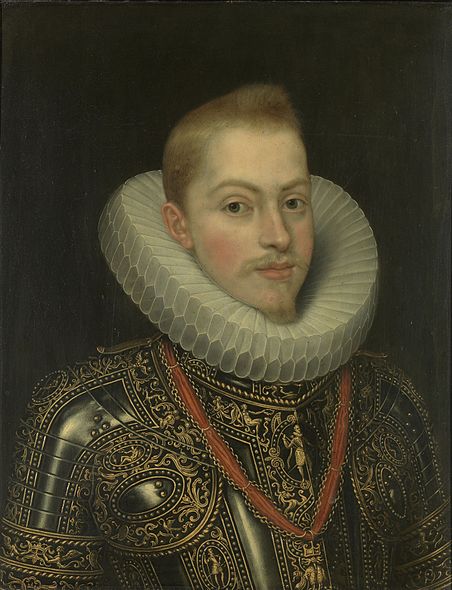- Joined
- Aug 13, 2004
- Messages
- 27,083
- City
- São Paulo
- Country
- Brazil
Philip III/II King of Spain, of Portugal and the Algarves, Sovereign of the Spanish Netherlands (Madrid, 14 April 1578 - Madrid, 31 March 1621); married in Valencia on 18 April 1599 Achduchess Margarethe of Austria (Graz, 25 December 1584 - El Escorial, Madrid, 3 October 1611)
Reign: 1598 - 1621
Predecessor: King Philip II/I of Spain and of Portugal and the Algarves
Succeeded by: King Philip IV/III of Spain, Portugal and the Algarves
Children: Queen Anne of France, Princess Maria and King Philip IV of Spain, Archduchess Maria Anna of Austria, Holy Roman Empress and Queen of Hungary, Prince Carlos of Spain and Prince Ferdinand of Spain, Archbishop of Toledo, Governor of the Spanish Netherlands, Princess Margarita and Prince Alfonso of Spain
Parents King Philip III/II: King Phillip II of Spain, King of Portugal and Archduchess Anne Marie of Austria
Parents Queen Margarita: Archduke Karl of Austria and Princess Marie Anna of Bavaria
Siblings King Philip III/II: Prince Carlos, Archduchess Isabella of Austria, governor of the Spanish Netherlands, Duchess Catalina Micaela of Savoy, Prince Fernando, Prince Carlos Lorenzo, Prince Diego and Princess Maria of Spain
Siblings Queen Magarita : Archduke Ferdinand, Queen Anne of Poland, Princess Maria Christina of Transylvania (Bathory von Siebenburgen), Archduchess Katharina and Archduchess Elisabeth of Austria, Archduke Ferdinand II of Austria, Holy Roman Emperor, King of Hungary, Archduke Karl, Archduchess Gregoria, Archduchess Eleonora and Archduke Maximilian of Austria, Archduke Leopold V of Austria, Holy Roman Emperor etc, Queen Constance of Poland, Grand Duchess Maria Magdalena of Tuscany and Archduke Karl of Austria
Reign: 1598 - 1621
Predecessor: King Philip II/I of Spain and of Portugal and the Algarves
Succeeded by: King Philip IV/III of Spain, Portugal and the Algarves
Children: Queen Anne of France, Princess Maria and King Philip IV of Spain, Archduchess Maria Anna of Austria, Holy Roman Empress and Queen of Hungary, Prince Carlos of Spain and Prince Ferdinand of Spain, Archbishop of Toledo, Governor of the Spanish Netherlands, Princess Margarita and Prince Alfonso of Spain
Parents King Philip III/II: King Phillip II of Spain, King of Portugal and Archduchess Anne Marie of Austria
Parents Queen Margarita: Archduke Karl of Austria and Princess Marie Anna of Bavaria
Siblings King Philip III/II: Prince Carlos, Archduchess Isabella of Austria, governor of the Spanish Netherlands, Duchess Catalina Micaela of Savoy, Prince Fernando, Prince Carlos Lorenzo, Prince Diego and Princess Maria of Spain
Siblings Queen Magarita : Archduke Ferdinand, Queen Anne of Poland, Princess Maria Christina of Transylvania (Bathory von Siebenburgen), Archduchess Katharina and Archduchess Elisabeth of Austria, Archduke Ferdinand II of Austria, Holy Roman Emperor, King of Hungary, Archduke Karl, Archduchess Gregoria, Archduchess Eleonora and Archduke Maximilian of Austria, Archduke Leopold V of Austria, Holy Roman Emperor etc, Queen Constance of Poland, Grand Duchess Maria Magdalena of Tuscany and Archduke Karl of Austria
Last edited:


